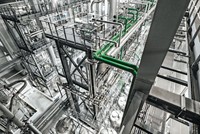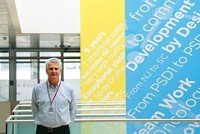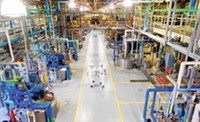Advertisement
Grab your lab coat. Let's get started
Welcome!
Welcome!
Create an account below to get 6 C&EN articles per month, receive newsletters and more - all free.
It seems this is your first time logging in online. Please enter the following information to continue.
As an ACS member you automatically get access to this site. All we need is few more details to create your reading experience.
Not you? Sign in with a different account.
Not you? Sign in with a different account.
ERROR 1
ERROR 1
ERROR 2
ERROR 2
ERROR 2
ERROR 2
ERROR 2
Password and Confirm password must match.
If you have an ACS member number, please enter it here so we can link this account to your membership. (optional)
ERROR 2
ACS values your privacy. By submitting your information, you are gaining access to C&EN and subscribing to our weekly newsletter. We use the information you provide to make your reading experience better, and we will never sell your data to third party members.
People
At 50, Hovione Takes A Big Step
Portuguese fine chemicals firm targets big pharma with a plant acquired from Pfizer
by Rick Mullin
June 8, 2009
| A version of this story appeared in
Volume 87, Issue 23

APRIL 8 was a big day for Hovione, the Portuguese pharmaceutical chemical manufacturer. The family-owned firm, based in the Lisbon suburb of Loures, marked its 50th anniversary and closed on the purchase of a Pfizer chemical plant in Cork, Ireland. Until recently, this plant manufactured the active ingredient in Lipitor, the top-selling drug in the world.
A random coincidence, perhaps, but chance has played a big role in the formation and growth of Hovione.
So has risk. Chief Executive Officer Guy Villax, the son of founder Ivan Villax, was out front among his peers in Europe's fine chemicals sector in launching small-scale active pharmaceutical ingredient (API) manufacturing in the U.S. and in establishing spray drying as a core technology. He is associated with his father's first big risk—building a plant in Macau in the mid-1980s. Guy managed Hovione's Macau office and, at the age of 24, oversaw the plant's construction. Last year, Hovione took on a second plant in Asia with the acquisition of China's Hisyn Pharmaceutical.
The stakes are particularly high in Guy's latest move—the conversion of the 427-m3 Pfizer plant into a multipurpose API facility that nearly doubles Hovione's global capacity. With the Cork plant, Hovione aims to ratchet up from its current customer base of small pharmaceutical and biotech firms to take on business with major drug companies.
The timing will make things interesting. Hovione's move coincides with a simultaneous push on the part of major drug companies toward increased outsourcing, which should help business, and a worldwide economic downturn, which is quite likely to hurt.
Hovione, which is planning to celebrate its 50th anniversary in September, hosted an inaugural event at the Cork plant in April. Guy led a tour of family members, journalists, and other visitors through the plant, including its towering, $90 million spray-dryer building. Pfizer built the dryer—which, with its curved glass facade, suggests a four-star hotel—in anticipation of producing torcetrapib, a cholesterol drug preordained to be the next Lipitor. Pfizer stopped work on it in late 2007 after setbacks in the clinic.
"It's anything an innovator ever dreamed of," Guy says of the Cork plant, noting the vastness of Pfizer's operation on a peninsula in nearby Ringaskiddy. The drug firm will continue to produce the Lipitor API in an adjacent plant.
"Six hundred people made products selling for $13 billion. It's not normal," Guy observes of Pfizer's operation in Cork. "You have this nowhere else in the world, and you are unlikely ever to have it again." Now, a significant part of that infrastructure will be available on a contract basis to large pharmaceutical companies, he says.
Although the facility is associated with one product, Lorcan McGarry, former head of engineering for Pfizer and now Hovione's plant manager in Cork, notes that it has manufactured a wide range of drug chemicals. It was built in 1985 by Angus Chemical and owned subsequently by Hickson International and Warner-Lambert. "Over the years, the plant made 77 different steps for different products," he says, asserting its viability as a multipurpose plant. "Equipment is equipment."
And Hovione needs the equipment, according to Guy. Since 2001, the firm has pursued work with customers at all stages of clinical development in the hopes that one or two molecules would become the subject of a New Drug Application. "We have a process chemistry capability that far exceeds our production capacity," he says. "In 2007, we reached 40 compounds in development," he adds. "And I am convinced there is a correlation between having 40 compounds and, four years later, having an NDA. By 2013, we want to have 110 compounds in development. That will take us to the next level."
With 2008 sales of $125 million, the company has experienced a compound annual growth rate of 8% for the past 15 years and growth in excess of 15% since 2006, Guy says. He anticipates 16% growth this year. Hovione's generics business accounts for 56% of revenue; exclusive synthesis for single customers, 24%; and particle design, 12%. A business in inhalants accounts for the rest.
Being family owned has helped Hovione move quickly on risky opportunities.
THE STORY of how a small, family-owned fine chemicals business near Lisbon grew to the point where it determined it needed a large Pfizer plant began with Guy's father, Ivan, a Hungarian chemist researching fermentation processes for semisynthetic tetracycline antibiotics and corticosteroid anti-inflammatories.
A refugee with his family after World War II, Ivan studied in France at the University of Clermont-Ferrand, receiving a degree in microbiology. Ivan's parents settled in Lisbon, where his father, a geneticist and university professor, was developing an agricultural research institute at the invitation of Victoria Pires, Portugal's secretary of agriculture.
"At some point, my father had a motorbike crash and broke both his legs," Guy says. "He decided to come to Mommy to be looked after. In the summer of 1951, he came to Portugal and liked it so much that he decided to start life again there." Ivan took a position at Institute Pasteur, where he was awarded several patents for fermentation processes.
These patents were of interest to two other Hungarian refugees, Nicholas de Horthy and Andrew Onody, who convinced Ivan to form a company that would license the patents to an Italian firm called Ferment Farma. Hovione's name derives from the first letters of the founders' surnames. But after landing the deal, Horthy and Onody opted to cash out. Ivan stayed and received 4.5% of the shares in Ferment Farma.
Ivan was restricted from competing in natural fermentation, however. "So he said 'fine' and switched to organic synthesis," Guy says. Among Ivan's accomplishments was a 16-step process for betamethasone, a glucocorticoid steroid with anti-inflammatory and immunosuppressive properties.
"My father's original plan was to do research, and he would have been happy working in a lab," Guy says. "He was successful, but I think he realized that nobody out there really believed that some Hungarian refugee in a basement in a house in Lisbon was able to come up with genuinely innovative chemistry. He thought, 'I obviously cannot live on royalties if nobody uses my chemistry. So I will have to build a plant and use the chemistry myself and make products using my know-how.' "
In 1969, Ivan established a manufacturing site in Loures, which became the company's headquarters and main production facility.
Over the years, a great deal of chemistry went on at that house in Lisbon, according to Guy, the second-oldest of the four children of Ivan and Diane Villax. "I remember not being allowed in the backyard because they were either doing Grignard chemistry or bromination," he says. "We weren't allowed on our bicycles on those days. After dinner, my father would go down to the lab to see how things were going. I remember distinctly the things going on. I remember my father showing me how he could extract chlorophyll from plants."
In the mid-1970s, the business received a boost from an unexpected quarter—Japan, where pending changes in patent laws were going to make it difficult for some firms to introduce new products. "When Japanese companies found in the Chemical Abstracts that this gentleman called Ivan Villax in Lisbon had a string of process patents around betamethasone, they got on the plane, literally, and came knocking on his door," Guy says. "What would he have done if the Japanese hadn't shown up? I don't know. But Ivan Villax had a business now. And he was looking to supply the American market."
The goal of becoming a global supplier led to plans in the early 1980s to make corticosteroids in Macau. It also created opportunities for the Villax children. Guy had recently graduated from the University of Buckingham, in England, and been working for Price Waterhouse. "His father sent him at the age of 23 to the Far East," recalls Diane, who managed Hovione with her husband in the early years. "We threw him to the lions."
With his older brother, Peter, handling sales in Japan, Guy started working as a salesman for Hovione in Hong Kong, covering Asia-Pacific. He then went to Macau to support the technical director overseeing construction of the plant. Eventually, he took over as general manager, with his sister, Sophia, on-site heading quality assurance.
"I thought building the plant would be the tough part," Guy says. "Managing it was much harder." The plant received its first inspection by the U.S. Food & Drug Administration in 1987. "We got our first deficiency letter, and it had 11 points," he says. "My technical manager looked at it and said, 'Oh my God!' The quality control lady started to cry. Sophia came around and said, 'Guy, what are we going to do?' We were all in our 20s. We had never seen one of these things before, and I was supposed to be the boss. I said, 'Let's go to lunch.' " After lunch, he says, he recommended working down the list in order from simplest to most difficult task.
"Guy has very much the same character as his father," says Diane, who attended the plant inauguration in Cork, noting that her husband left Hungary at the age of 23. "Although Guy didn't pursue science, he has absorbed it." His training and experience as an accountant—which included auditing failed airline mogul Freddy Laker—bolstered his management skills, according to his mother.
Her son concurs. "Looking back, it was a godsend that I didn't end up a chemist," Guy says. He credits his father's vision and skills as a scientist in establishing the firm, but other skills were required.
As Hovione grew, management challenges changed significantly. "Until 1995, this company didn't have a very good understanding of managing and developing managers. It was a very primitive kind of command and control," says Guy, who took the CEO title in 1998. "And I think one of my biggest challenges since then has been to come up with a good management team and ways to motivate people and get ownership and accountability."
With Ivan's death in 2003, Guy assumed the head position in the company. But he had lost what he calls his reporting line. "I went to my family and told them I need to have a mechanism by which my performance can be judged," he says. He and his mother established a board of directors on which they both sit—Diane as chair. It also includes Federico G. M. Mennella, a banker with Lincoln International, in New York City, and Stephen J. Hoffman, a partner in Boston's Skyline Ventures, both of whom have been involved with chemical industry deals. Hoffman was formerly chief executive of Allos Pharmaceuticals, a Hovione customer.
Of the latest venture in Cork, Diane says the company has made a necessary move. "It was a risk, but in this day and age, there is no longer talk of consolidation in the sector, and you can't stagnate," she says. "I'm too old not to take a risk, so I told Guy, 'I'm with you and Daddy would be with you.' "
A WALK THROUGH Hovione's headquarters facility in Loures suggests that the firm has no room to expand there. Built on one of the hills that characterize the rolling landscape near Lisbon, the facility stretches to the yards of nearby houses, some of which Hovione purchased and turned into office space. In one corner, a small orange grove has been preserved, its trees framed by production pipe.
"We looked around Portugal and Spain to expand," Guy says. "It wasn't easy." Other plants for sale, such as AstraZeneca's plant in Dunkirk, France, did not meet criteria for capacity or location. "Our chief criterion was capacity with wide-ranging capability. We needed something that is absolutely, fundamentally designed for multipurpose manufacturing, which is almost by definition something big pharma doesn't do."
But the Pfizer plant, Guy contends, meets that criterion with the added benefit of location. Thanks to tax breaks, Irish pharmaceutical production in the 1990s was so successful that contract manufacturing capacity there is in tight supply. "So there is no contract manufacturing in Ireland until Hovione shows up with this plant," he says with some hyperbole.
Advertisement
Not everyone sees the move as such clear sailing, Guy admits. He shares a Christmas card he received from Peter Pollak, an industry consultant who formerly ran Lonza's contract manufacturing business.
"It says, 'I'm worried about you buying this plant because it is a dedicated plant to Lipitor, and multinationals run these as cost and not profit centers,' " Guy relates. " 'You now have four sites to worry about. And you do so many things besides running your company. I really am worried about you. So, good luck anyway.' "
Guy smiles. "I was delighted that these were the things he was concerned about," he says. Insisting that the Lipitor plant is versatile enough to serve as a multipurpose contract facility, he concedes that managing cost in Cork is the name of the game. "The road map is about handing out responsibilities and expecting a lot from Hovione," he says. "This means being flexible and making sure the plant looks fantastic when customers come. It means whenever customers want us to do miracles, I can count on the people in Cork to do miracles."
DESPITE CONCERNS, Pollak says he is by no means ready to count Hovione out. "They have a lot of projects and not much capacity. This was a cheap way to get capacity—they didn't pay much, and there were tax breaks," he says, adding that the move is in keeping with Hovione's history of high-stakes risk-taking. "Guy is a real entrepreneur."
James Bruno, president of the consulting firm Chemical & Pharmaceutical Solutions, agrees. "Guy has never been averse to taking risk," he says. "He always puts a good plan in place. Hovione is a well-run company." Bruno points out, however, that he generally advises companies not to acquire manufacturing facilities from drug firms, contending that once the typical short-term supply agreement with the seller runs out, the buyer is usually left with a lot of idle capacity.
"It is a risky move, but I have some confidence he is going to pull it off," Bruno says. "He has a track record. I think he's got a plan in place, and, hopefully, he's got a backup plan. We may not see it right now, but I'd be very curious to have this conversation in four years."
Guy says he is confident that the Cork investment is a manageable risk. "The scale of risk diminishes with your size," he says. "In 1984, when we built the plant in Macau, the investment was $5 million for a 30-m3 plant. At that time, Hovione's total annual sales were $5 million. It never crossed our minds we were betting anything insofar as my father had not the shadow of a doubt. Sales were growing; we needed capacity."
Being family owned has helped Hovione move quickly on risky opportunities. Guy says the company is likely to operate at a loss for two years in Cork, a scenario that would no doubt have been a deal-killer for a public company. And Guy does not see the ownership structure changing. "If our customers required us to be listed, we could do that in no time," he adds.
As for Hovione being Villax-run, that is another story. All of Ivan's children have been involved with the company at some point. His youngest, Miguel, who owns a business software firm, developed an Internet-based system that coordinates Hovione's business and laboratory information technology worldwide.
"But I don't imagine that the next chief executive is going to be a Villax," Guy says, although Diane does have 16 grandchildren. "We are a company that needs the best chief executive it can find from the perspective of the customers, employees, and shareholders. If that person happens to be a Villax, then, wow. Great! That makes for good alignment between ownership and management."






Join the conversation
Contact the reporter
Submit a Letter to the Editor for publication
Engage with us on Twitter